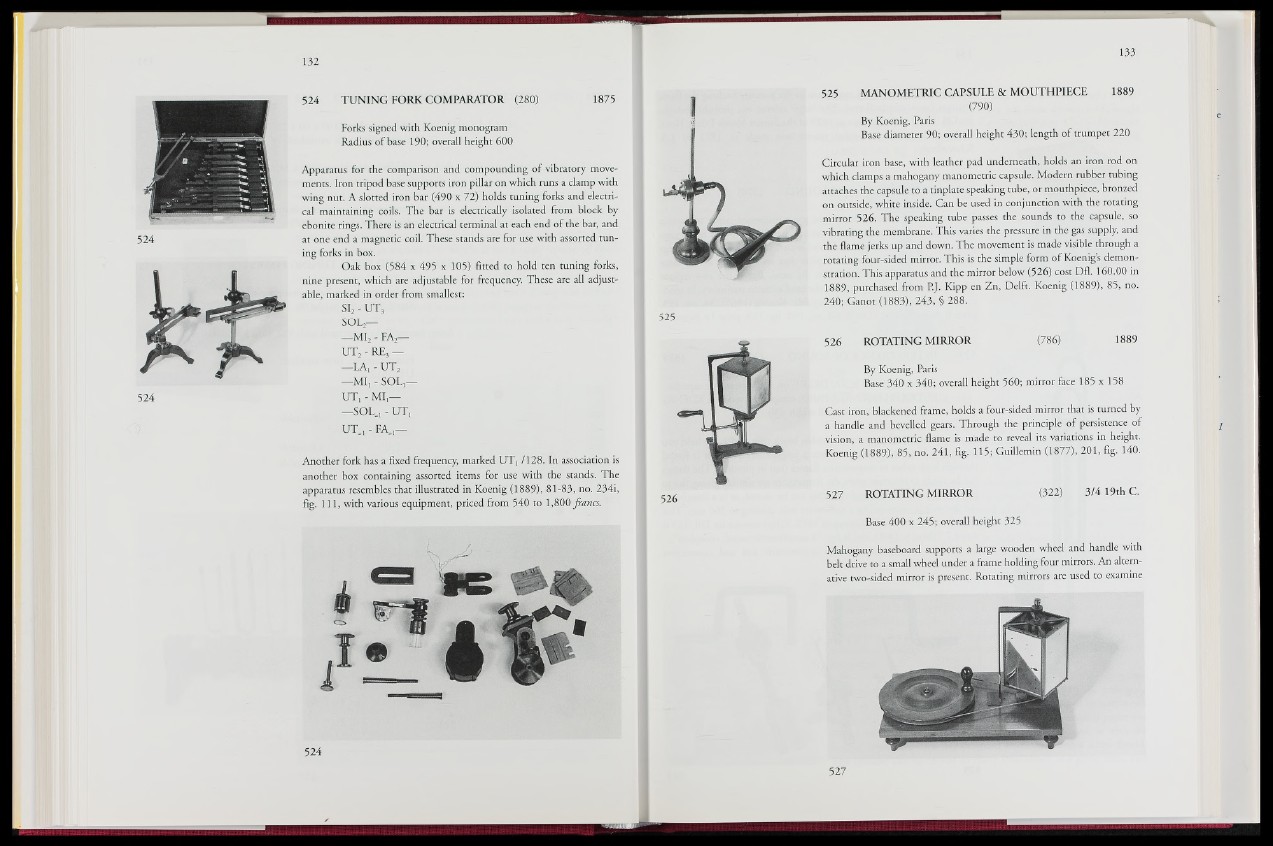
524 TUNING FORK COMPARATOR (280) 1875
Forks signed with Koenig monogram
Radius of base 190; overall height 600
Apparatus for the comparison and compounding of vibratory movements.
Iron tripod base supports iron pillar on which runs a clamp with
wing nut. A slotted iron bar (490 x 72) holds tuning forks and electrical
maintaining coils. The bar is electrically isolated from block by
ebonite rings. There is an electrical terminal at each end of the bar, and
at one end a magnetic coil. These stands are for use with assorted tuning
forks in box.
Oak box (584 x 495 x 105) fitted to hold ten tuning forks,
nine present, which are adjustable for frequency. These are all adjustable,
marked in order from smallest:
s i2 - u t 3
SOLj—
—MI2 - FA2—
u t 2 - r e 3 —
—LA: - UT2
—MI, - SOL,—
UT, - MI,—
—SOL., - UT,
UT I FA.,—
Another fork has a fixed frequency, marked UT, /128. In association is
another box containing assorted items for use with the stands. The
apparatus resembles that illustrated in Koenig (1889), 81-83, no. 234i,
fig. I l l , with various equipment, priced from 540 to 1,800 francs.
525 MANOMETRIC CAPSULE & MOUTHPIECE 1889
»'{11790)
By Koenig, Paris
Base diameter 90; overall height 430; length of trumpet 220
Circular iron base, with leather pad underneath, holds an iron rod on
which clamps a mahogany manometric capsule. Modern rubber tubing
attaches the capsule to a tinplate speaking tube, or mouthpiece, bronzed
on outside, white inside. Can be used in conjunction with the rotating
mirror 526. The speaking tube passes the sounds to the capsule, so
vibrating the membrane. This varies the pressure in the gas supply, and
the flame jerks up and down. The movement is made visible through a
rotating four-sided mirror. This is the simple form of Koenigs demonstration.
This apparatus and the mirror below (526) cost Dfl. 160.00 in
1889, purchased from P.J. Kipp en Zn, Delft. Koenig (1889), 85, no.
240; Ganot (1883), 243, § 288.
526 ROTATING MIRROR (786) 1889
By Koenig, Paris
Base 340 x 340; overall height 560; mirror face 185 x 158
Cast iron, blackened frame, holds a four-sided mirror that is turned by
a handle and bevelled gears. Through the principle of persistence of
vision, a manometric flame is made to reveal its variations in height.
Koenig (1889), 85, no. 241, fig. 115; Guillemin (18?f), 201, fig. 140.
526 527 ; ROTATING MIRROR (322) 3/4 19th C.
Base 400 x 245; overall height 325
Mahogany baseboard supports a large wooden wheel and handle with
belt drive to a small wheel under a frame holding four mirrors. An alternative
two-sided mirror is present. Rotating mirrors are used to examine